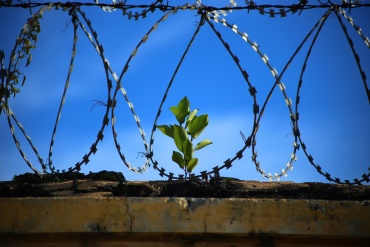Our latest news
Charlotte Wise, Occupational Therapist at HMP Stoke Heath, on the importance of looking at a person as a whole
No. 5 in our blog series exploring creative approaches to transforming the criminal justice system.
Author: Charlotte Wise, Occupational Therapist based at HMP Stoke Heath
The role of an occupational therapist can vary depending on the area of practice but occupational therapy takes on a whole person approach to both mental and physical well-being in order to enable an individual to achieve their full potential (Royal College of Occupational Therapy, 2020).
I found occupational therapy when I was working in a medium secure hospital. The occupational therapists always appeared happy and keen to engage individuals. They offered the patients a variety of opportunities to participate in meaningful occupations including assessing self-care tasks, developing domestic skills, increasing leisure activities with an aim to encourage service users to be more independent and develop a positive daily routine.
The profession provided me with the opportunity to fulfil my passion – I had always been keen to work with individuals with mental health issues and a forensic history. I was keen to know why people commit crime, what leads them to these decisions in life, and to think about how I could help them rebuild their lives.
Over four years ago, I started working in the secondary mental health team at HMP Stoke Heath. I was keen to think about how I could apply my occupational therapy skills to the service users in the prison establishment and make improvements to their lives.
Much of the work I started and still do with the individuals on my caseload involves psychological interventions such as Cognitive Behavioural Therapy or Compassion Focused Therapy. This has great benefits to the individuals I work with, as being able to recognise and manage emotions more effectively can impact on their thoughts, feelings and behaviours, which will hopefully keep them out of trouble.
As my role developed further, I was keen to be more focused on the occupational therapy element of my practice and I started to introduce some new interventions to service users. This included a Recovery through Activity weekly group programme and working with the Good Vibrations team to offer a week-long intervention. These offered service users opportunities to engage in new occupations and make them think about activities that they used to enjoy.
Feedback from Recovery through Activity project indicated positive benefits for all participants involved. One patient reported that he had started to engage more in physical activities, and as a result he was sleeping better at night and getting up earlier. Following the Good Vibrations project, individuals reported that they felt better about themselves, felt happier, were feeling more confident, had improved relationships with others, improved listening skills and started taking part in more activities and groups.
At the present time, there are increased COVID restrictions in the prison establishment, meaning that prisoners are in their cells for long periods of the time, often up to 23 hours a day. During this time, I wanted to continue to utilise my occupational therapy skills, encouraging individuals to maintain a positive daily routine and engage in meaningful activities.
For the past 12 months, I have reached out to a significant number of prisoners to offer them additional distraction materials including colouring, puzzles, board games, relaxation activities, in-cell workouts and competitions. This has been a great opportunity to spread the work about my role and how we can help others even in the restrictions which are forced upon us.
The occupational therapy service is available for all the prisoners who reside at HMP Stoke Heath, they can be referred via a healthcare professional, prison staff or self-refer. However, there is only me, and there are 700 prisoners in the establishment, so as a result I am unable to help everyone. I hope that, in the future, there will be an opportunity for the employment of another occupational therapist to assist with providing further meaningful occupations to the prisoners here, and add to what is already available through education and vocational opportunities.
I feel the role of the occupational therapist can have a significant impact in the prison environment, offering individuals additional chances and opportunities which they may not have experienced in the community. Occupational therapists will look at the person as a whole and address what the person would like to achieve, their goals and their ambitions. Encouraging individuals to focus on what they would want to achieve, as opposed to what they are being asked to do in a sentence plan, makes this more person-centred. Increasing the focus onto the individuals can encourage empowerment and hope, increase their self-esteem and self-confidence. Developing these skills could assist individuals on leaving custody.
It is difficult to know whether occupational therapy has an impact on reoffending rates. However, I can only presume that if people have other occupations to engage in, feel more motivated to engage in pro-social activities and feel more positive about themselves, this can only have good effects on their physical and mental well-being.
_______
Good Vibrations has worked in prisons and young offender institutions since 2003. We see the destructive effects on people of living within our overstretched, under-resourced criminal justice system. We want to understand how people can be better supported before, during and after their contact with the criminal justice system. We have commissioned a series of blogs from a range of experts, including those with lived experience and their families. Every Thursday for the next four months, we will bring a different voice with their own unique perspective and ideas. At the end of the series we will publish a report drawing together the themes and recommendations.
